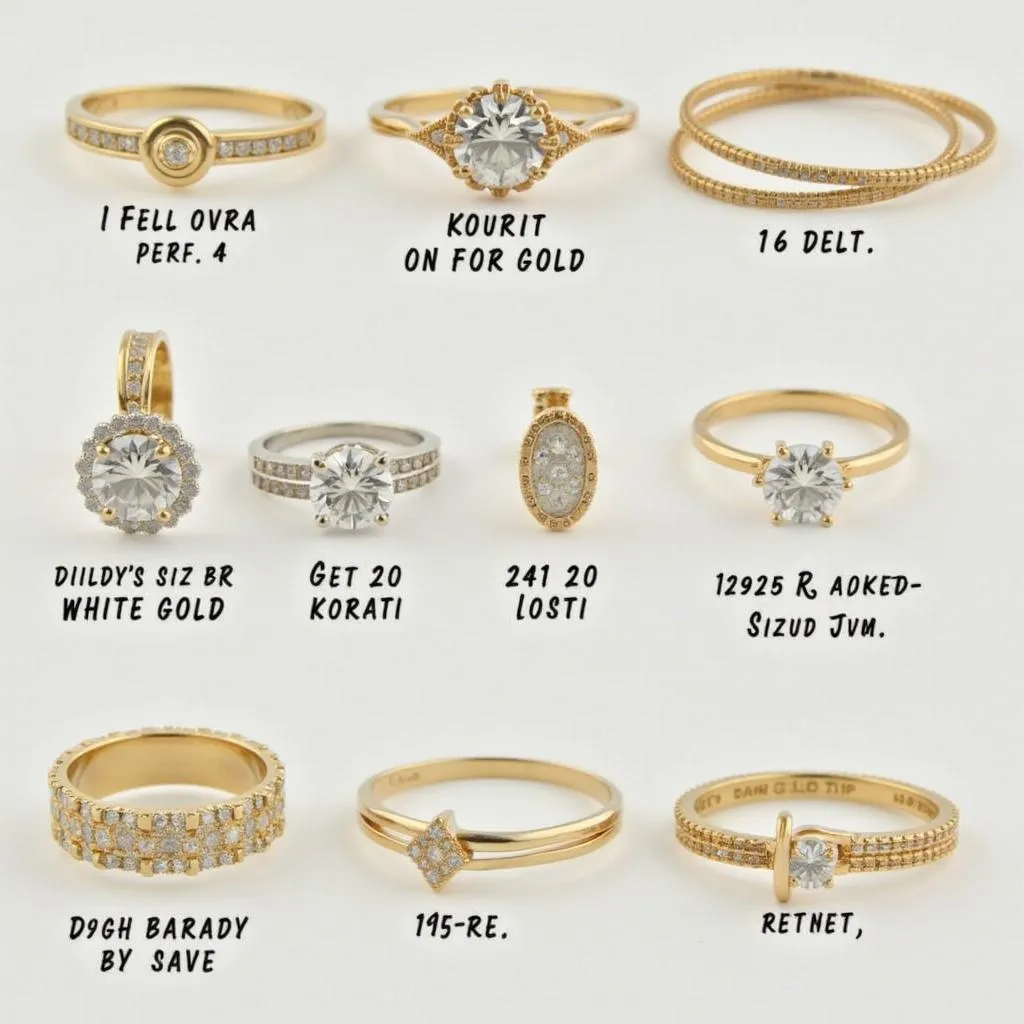White gold is a popular choice for jewelry, prized for its elegant, silvery-white sheen. But can white gold change color? The answer, like many things in the world of metals, isn’t a simple yes or no. Let’s dive into the fascinating world of white gold and explore the factors that can affect its color.
Understanding White Gold: A Blend of Metals
First, it’s essential to understand that white gold is not a naturally occurring metal. It’s an alloy, a mixture of pure gold and other white metals, such as palladium, silver, and nickel. These additional metals are what give white gold its characteristic pale hue.
The Role of Rhodium Plating
To further enhance its whiteness and brilliance, most white gold jewelry is coated with a thin layer of rhodium. Rhodium is a durable, highly reflective metal from the platinum family. This plating gives white gold that extra sparkle and protects it from scratches.
 White gold jewelry with rhodium plating
White gold jewelry with rhodium plating
So, Does White Gold Really Change Color?
Technically, the white gold itself doesn’t change color. However, the rhodium plating can wear down over time, revealing the slightly yellowish hue of the gold alloy underneath. This is especially true in areas that experience more friction, like rings.
Several factors can affect the rate at which rhodium plating wears off:
- Frequency of wear: The more you wear your white gold jewelry, the faster the plating will wear down.
- Skin pH: Your skin’s pH level can affect the durability of the rhodium plating.
- Chemicals and abrasives: Exposure to harsh chemicals, perfumes, and even certain soaps can accelerate the wearing process.
How to Tell if Your White Gold Needs Replating
If your white gold jewelry starts to look dull or slightly yellow, it’s likely time for replating. A professional jeweler can easily reapply a fresh layer of rhodium, restoring your piece to its original brilliance.
 Worn white gold ring needs replating
Worn white gold ring needs replating
Other Factors Affecting White Gold’s Appearance
While rhodium plating is the most common reason for color changes, other factors can also play a role:
- Nickel allergy: Some white gold alloys contain nickel, which can cause allergic reactions in sensitive individuals. This reaction can lead to discoloration of the skin and the jewelry itself. If you have a nickel allergy, opt for nickel-free white gold.
- Tarnish: Like all metals, white gold can tarnish over time due to exposure to air and moisture. However, this tarnish is usually a slight dullness and can be easily cleaned with a polishing cloth.
Caring for Your White Gold Jewelry
To keep your white gold looking its best, follow these simple tips:
- Clean regularly: Gently clean your jewelry with a soft cloth and warm, soapy water.
- Avoid harsh chemicals: Take off your white gold jewelry before showering, swimming, or cleaning.
- Store properly: When not wearing, store your jewelry in a cool, dry place, preferably in a separate compartment or pouch to prevent scratching.
- Get it replated: Consider getting your white gold jewelry replated every few years, depending on your frequency of wear.
White Gold: A Timeless Choice
Even though the rhodium plating on white gold may eventually wear down, it remains a popular choice for its timeless elegance and versatility. If you love the look of white gold, don’t let the possibility of replating deter you. With proper care, your white gold jewelry will continue to shine brightly for years to come.
 Different karats of white gold
Different karats of white gold
If you’re looking for ways to enhance your personal style with colors, check out what color goes best with my skin tone. This guide can help you discover the perfect shades to complement your unique complexion.
FAQs
- How often should I get my white gold replated?
- This depends on how often you wear the jewelry and your lifestyle. Generally, replating every 2-4 years is recommended.
- Can I replate white gold at home?
- It’s not recommended. Rhodium plating requires specialized equipment and expertise.
- Is white gold more expensive than yellow gold?
- The price of white gold can vary depending on the alloy and rhodium plating, but it is often comparable to yellow gold.
- Does white gold turn silver?
- White gold doesn’t “turn” silver, but the rhodium plating can wear off, revealing the slightly yellowish hue of the gold alloy underneath.
- Is white gold hypoallergenic?
- Not all white gold is hypoallergenic. Some alloys contain nickel, which can cause allergic reactions. Look for nickel-free white gold options.
If you’re curious about other interesting color-related questions, explore what is the color for 10 year anniversary.
For those looking to add a touch of vibrant color to their wardrobe, discover what colors match olive for stunning outfit combinations.
And if you’ve ever wondered about the best eyewear for your features, check out what glasses color should I get for expert advice.
Should you find yourself needing assistance in removing unwanted color stains, our comprehensive guide on how to remove color stains from white clothes will provide valuable tips and tricks.
For any further assistance or inquiries, please reach out to us at 0373298888 or email us at [email protected]. You can also visit our showroom at 86 Cầu Giấy, Hà Nội for personalized consultations. Our dedicated team is available 24/7 to assist you with all your color needs.

